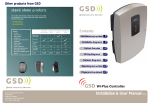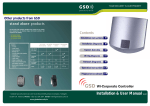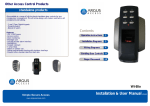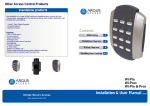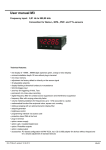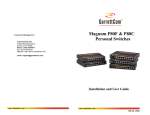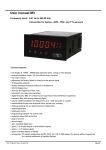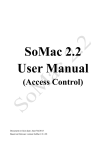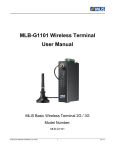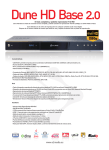Download Installation & User Manual V2.062
Transcript
Other Access Control Products standalone products Also available is a range of fully functional standalone door controls for less complex door management. This attractive design, with modern aesthetics, will complement and building. - 1 and 2 Door Digital Keypads - Proximity Switch - Biometric Switch Features: - (35 - 1000) users - Access control - Door monitoring - Manager user - fire and intruder alarm interface - Backlighting - Tamper resistant - 5 amp relays - Indoor or outdoor use - Robust polycarbonate housing with stainless steel keys - Mounts onto a standard electrical back box Contents Installation Instructions 3 Installation Diagrams 4 System Overview 6 Wiring Diagrams 8 Network Diagrams 9 Operating Instructions 12 Fingerprint Enrollment 19 Wi-Plus Controller Simple Secure Access www.argusaccess.com Installation & User Manual V2.062 Installation Steps 2 Technical Specification Installation Steps Technical Specs - Wi-Plus Controller Power Supply Current consumption Current consumption with load (max) Relay Contact Rating Moisture Resistance Dimensions 12 DC 120mA 160mA 5 Amps /240V ac Indoor Use Only W. 135mm D. 46mm H. 200mm Technical Specs - Wi-Plus Door Controls Power Supply Current consumption Current consumption with load (max) Relay Contact Rating Operating Temperature Moisture Resistance Dimensions - Flush Mount - Surface Mount 12 DC 110mA 145mA 5 Amps /240V ac - 20 C to +60 C IP 67 ( IP65 on Wi-Bio ) W. 87mm D. 21mm H. 119mm W. 87mm D. 35mm H. 119mm Features Doors controlled Users User Groups Time Zones Door Groups Reporting Facility Challenge Facility Logging Input/Output Mapping Supports Wireless & RS485 Networks Automatic Backup Facility Database Encryption 10 5000 16 16 16 Yes Yes Unlimited CCTV & Lift control Yes Yes Yes Step Description Page 1 Install the Controller using the Installation Diagrams 4-5 2 Wire the Controller using the Wiring Diagrams 8 3 Install and wire each Door Control. Refer to the Door Control Manual for instructions. 4 Connect the Controller to the PC using Network Diagrams 9-11 5 Restoring Factory Defaults 11 6 Phase 1- Setting up the Ccontroller 12 7 Phase 2 - Configuring the Controller 13 8 Phase 3 - Enrolling Door Controls 9 Phase 4 - Configuring Users 17 10 Phase 5 - Configuring Access Levels 18 11 Phase 6 - Downloading Configuration 18 12 Enrolling User Fingerprints 19 13 Correct Finger Placement techniques 14-16 20-23 3 4 Installation Diagrams Installation Diagrams 1. To open front cover of Controller, remove screw cap using screwdriver then loosen screw. 3. screw the rear enclosure to the wall. as shown below. 2. Remove door from unit (see inset) before screwing the rear enclosure to the wall. To remove front cover lift tab up and unhook door. 4. Re-attach the front cover To re-attach front cover: hook door over top pip and rotate into position and push tab down to secure. Use for retaining cables. 5 6 System Overview System Overview RS485 Connection to Door Controls Note: If using a single Controller, an RS232 cable may be used. Max cable length 10 meters Wireless Connection to Door Controls RS485 Network to Controllers Max number of Controllers 3 Max Cable Length 1.4 km Note: If using a single Controller, an RS232 cable may be used. Max cable length 10 meters RS485 Network to Controllers Max number of Controllers 3 Max Cable Length 1.4 km Controller #2 - 3 Place a 120ohm Termination Resistor across A & B on the Controller Controller #2 - 3 Controller #1 Controller #1 Door Control #4 RS485 Network to Door Controls Max Cable Length 1.4 km. Daisy Chain Configuration Only. Door Control #1 Place a 120ohm Termination Resistor across A & B on the last Door Control in the chain. Door Control #1 Door Control #2 Door Control #3 Door Control #4 - 10 Door Control #3 Door Control #2 Note: Door Controls can be installed within 30 meters of the Controller or within 30 meters of any other Door Control as each Door Control will function as a repeater. Each Door Control transmits data to/from the Controller. These distances are a guideline. The actual communication range depends on building shape and construction methods used. Door Control #5 - 10 7 8 Network Diagrams Wiring Diagrams Network Diagrams for Single Controller Wiring Diagrams with Fire Alarm 12V Sounder DB9 Female Serial Cable Relay 2 7 Power In Relay 1 Connect DB9 cable to serial port on PC +V 0V Maximum cable length 10 meters 8 9 2 3 4 A B 0V TX RX 5 Door Network A B COM 6 1 PC Direct NC COM NO NC COM NO PC Network VOUT OP3 OP4 A B COM TX RX PC Direct Door Network 12V Linear Power supply PC Direct Connection can be used, when using ONLY one Controller. TCP_IP Note : Used ONLY for Wired 485 Network Connections. A B 0V Outputs PC Netwrok PC Network Connections can be used for multiple controllers See page 10 for wiring Use PC Direct Connections if using a single controller See page 9 for wiring A B 0V Set the Direct address to ALL dip switches OFF (see below ) ON OFF 1234 IP4 IP3 0V IP2 IP1 Inputs 3V Lithium 0V 1234 ON OFF Fire Alarm Panel NOTE: Common OV from the Fire Alarm Panel and the OV from the Controller to avoid any ground loop issues. When the fire alarm is activated ( ie 0V removed from IP3) the local door will be opened. Direct Connect - All Dip Switches OFF See page 11 on “Configuring Controller Communication” to setup the application for serial communications 9 Network Diagrams 11 10 Network Diagrams Configuring Controller Communications Network Diagrams for Multiple Controllers 12V 19200 12V - 1 0V - 2 B-3 A-4 The Controller Address is set by configuring the Dip swithces as shown below. A 1234 ON OFF 0V B Setting the Controller address 1234 ON OFF PC Network Connections, when using more than one Controller. Daisy Chain each controller A B 0V TX RX 1234 ON OFF Set Baud Rate to 19200 PC Direct Connect using RS232-RS485 cable to serial port on PC Controller 1 PC Netwrok 9600 RS485 Converter Step Description 1. On the “Controller” tab, set the “Connection - Type” to “Serial” 2. On the “Settings” tab in the communications section, Select the Serial Port number from the drop-down list connected to the Controller. Daisy chain the PC network A , B , 0V to each controller. IP4 IP3 0V IP2 IP1 IP4 IP3 0V IP2 IP1 IP4 IP3 0V IP2 IP1 Set an individual address for each controller between 1 & 3 using the dip switches (see below ) Controller 2 PC Netwrok Controller 1 Controller 2 PC Direct A B 0V TX RX Address 2 - Set SW2 ON Address 3 - Set SW3 ON IP4 IP3 0V IP2 IP1 Address 1 - Set SW1 ON Address 2 - Set SW2 ON Restoring Factory Settings 1234 ON OFF IP4 IP3 0V IP2 IP1 IP4 IP3 0V IP2 IP1 1234 ON OFF 1234 ON OFF 1234 ON OFF Controller 3 Direct Connect - All OFF Address 1 - Set SW1 ON Note: Address 3 - Set SW3 ON only To restore the factory default setting , Set ALL Dip Swithces 1,2,3 & 4 to the ON position and then power-up the Controller. Example: All Dip Swithces are set to the ON position. Note: Factory Default settings will be restored after powering up the controller with All dip-swithces ON. The dip-switchess should then be set to the controller address as shown above in section “Setting the controller address” Operation Instructions 13 12 Operation Instructions Phase 1 - Setting up the Controller Step Description 1. Install the main Controller and power up 2. Default the controller immediately via the dip switch settings (see instructions on page 11 3. Important! Once powered up and the controller has completed the default the process – reset the dip switches to the correct address positions. (see instructions on page 11) 4. Follow instructions on the CD provided to install the PC application. Note: Make sure the USB enrollment reader is not connected to the PC before the application is installed. 5. Launch the application: A. Launch the application by clicking the PC app icon on the desktop. B. Click Create a new Wi-Plus Site and give it a name of the new installation site. C. Log in to the application as the Engineer (not the administrator) with the password 6666. D. Connect to the Controller. Refer to page 12 & 13 for setting up DHCP or Static IP addresses E. The Controller icon will change colour to show that the Controller is on-line. F. Go to the 'Current Events' tab and verify the log messages indicate the controller is on-line. Phase 2 - Configuring the Controller Step Description 1. Open the ‘Doors’ tab in the main menu to add the required number of new doors to be part of this network. One door will already be added by default. Click on the “+” button to add new doors. “-” to remove doors. 2. Make sure all doors are “Enabled” and then click “Save”. 3. Open the Settings Tab and do a “Configuration Download” to the Controller – this gives the Controller a clean set of instructions before beginning to enroll doors onto the network. This will take approximately 1 minute. 4. WARNING! A New Network should only be created on first installation. Creating a new network will overwrite any existing network information and any enrolled Door Controls will be un-enrolled. All Door Controls will have to be defaulted and re-enrolled on the new network that has just been created! A new network is now ready to be created. Go to the ‘Controllers’ tab and Click on the ‘Wireless Network’ and then the ‘Create a New Network’ button. Click Yes on the pop-up to proceed. Note: It will take about 20 - 60 seconds to complete. a pop-up will appear when the netwrok has been created. Operation Instructions 15 14 Operation Instructions Phase 3 - Enrolling Door Controls Step Description All Door Controls should be installed at this point and powered up. 1. All Door Controls must be defaulted before joining a network. Note: Door Controls will be shipped with their factory default settings. Enter Engineer mode on each Keypad Door Control in the following way A. Press X followed by 6666 B. Enter 55 –to default C. Press the tick to confirm – the keypad will now go through the process of defaulting itself. D. The process could take 20-30 seconds. The LED will flash once every second when it is complete E. Repeat the process for all keypad Door Controls Enter Engineer mode on each Wi-Bio Door Control in the following way A. Enter 6666 B. Enter 55 –to default C. Scan Finger to confirm – the Door Control will now go through the process of defaulting itself. D. The process could take 20-30 seconds. The LED will flash once every second when it is complete. E. Repeat the process for all Wi-Bio Door Controls Enter Engineer mode on each Prox Only Door Control in the following way A. Add a programming card to the Door Control by presenting a card twice on power-up. The security wing must be removed first! B. Present this new programming card to enter Engineer mode. C. Present the programming card again to select “Default mode”. D. Present any other card once to default the Door Control. E. The process could take 20-30 seconds. The LED will flash once every second when it is complete Phase 3 - Enrolling Door Controls Step Description 2. The controller is now ready to allow Door Controls to enroll onto the Network – Go to the ‘Controllers’ tab and Click on the ‘Wireless Network’ and thenclick the “Allow Doors to Join” start the controller scanning for new doors that do not already have an address – only DoorControls without an address can be enrolled. Note: For Wired 485 Door Controls, right click on the Controller on the right hand side of the application and select ‘Manually Assign Address’ from the drop down menu. Once all new Door Controls are found by the Controller they will all ‘beep’ with the number of the next available address/door position on the Controller. e.g. if door 2 is the next available address then all Door Controls will beep at the same time with 2 beeps. This is basically saying that any door can be assigned to this address – it’s up to the installer to decide which one. Also – you will notice that the Key back light of the keypad Door Controls will be illuminated with the next available address as well. i.e. Key 2 will be illuminated for this example. 3. Go to the Door control that you want to make door 2 on the network system (it should be beeping 2 times). Press any key on this keypad and the system will automatically assign this door control to door 2 address on the system. Present a card if the Door Control is Prox Only. Note: All other Door Controls will now start beeping with the next available address i.e. ‘3 beeps’ (address 3) in this instance and so on every time you enroll a new Door Control. The Key back light will also correspond to each address as the system fills up. Operation Instructions 17 16 Operation Instructions Phase 3 - Enrolling Door Controls Step Description 4. 5. Once all Door Controls are enrolled onto the network – go back to the Controller application and click the ‘Secure Network’ button –this safeguards the systems –if you select another tab on the application this will happen automatically. Select each Door on the application and configure individual settings such as Door Name, Timed Actions, Relay Times, Ajar Times, Door Option and Alarm Options etc. IMPORTANT: A timezone must be selected in ‘Timed Actions’ for one of the options: Card and PIN, Any Card, Card or PIN , or PIN only. If all of these are set to ‘inactive’ then access will be denied for all cards and PINs on that Door Control. Example: To Enable PIN codes only on a Wi-PIN&Prox: Set the Timed Action “Card or PIN” to “Inactive” and set the Timed Action “PIN Only” to “All day,Every Day”. This will grant access for PIN codes and deny access for cards and fobs. Phase 4 - Configuring Users Step Description 1. Enable a User by ticking the ‘Enabled’ box for each User 2. Assign a Name to the User 3. Assign a UserGroup from the drop-down menu. The Usergroup will determine the access levels for this User. Refer to section on page 18 ‘Configuring Access Levels’ for information on User Groups. 4. Assign a Card , PIN number and enroll FingerPrints for the User. Refer to section FingerPrint Enrolment on page 20 Click ‘save’ to transmit these changes to the Controller. Operation Instructions 19 18 Operation Instructions Phase 5 - Configuring Access Levels Step Description Access Levels are controlled by creating UserGroups and assigning the UserGroup to a User as decribed in section ‘Configuring Users’. 1. 2. 3. UserGroups are created by combining pairs of DoorGroups with Timezones. Each UserGroup can have up to 6 pairs of DoorGroups and Timezones. Select DoorGroups and Timezones from the drop-down menus to add to the current UserGroup. Step Description Note: Make sure the USB Fingerprint reader is attached to the PC 1. DoorGroups are created by grouping doors together. e.g all the entry and exit doors could be grouped together as ‘Peremiter Doors’. Select a Door from the ‘All availble Doors’ window and drag it to the ‘Doors in Current Door Group’ to add it to the Door Group. Repeat for adding each door. Step Description After all users, access levels and door control settings have been finalised, a full download to the controller should be carried out. Go to the ‘Settings’ tab and click on ‘Download Configuration’. A pop-up window will appear, tracking the status of the download. All settings will be downloaded to the Controller and Door Controls. On the Users Tab , Select a User for fingerprint enrollment 2. Click on the ‘Fingerprints’ button. 3. Click on ‘+’ button to begin and place finger on the enrolment reader. An image of the fingerprint will appear on the screen. Ensure that the image quality is good and a value of at least 90% is achieved. Refer to section ‘Finger Placement’ for correct finger placement and example of good quality image. Repeat this process if this is not achieved on first attempt. 4. Click ‘Save’ using a good quality template only. Poor Quality templates can lead to false rejections later when trying to gain access . Timezones are the periods of time for each day of the week that access will be granted. Select times and tick the days of the week this time is valid. 4 time periods can be created for each timezone. Select ‘Holiday Access’ to grant access for holiday periods. Double click on the ‘Holiday Access’ to add days to the holiday periods. Use the calender to select these days. Phase 6 - Downloading Configuration 1. Enrolling User FingerPrints Placement Wi-BIO 21 20 Placement Wi-BIO Correct Finger Placement Incorrect Finger Placement Note: Incorrect placement : finger does not fully cover the sensor window. Good Quality Image Note: Ensure that the core of finger is centered on the sensor window during the enrollment process. This will increase the quality of the fingerprint template. Ensure a value of at least 90% is achieved. Note: Good Quality image, Fingerprint core is center of sensor window Note: The System does not store the finger print. It uses an algorithm to generate a binary representation using sample points from the fingerprint. It uses this information to then validate each users fingerprint. Poor Quality Image Note: Poor Quality image, No Fingerprint core on sensor window. This can result in poor template quality that can lead to false rejection issues later when the user is trying to gain access. Placement Wi-BIO 23 22 Placement Wi-BIO Correct Finger Placement Incorrect Finger Placement













